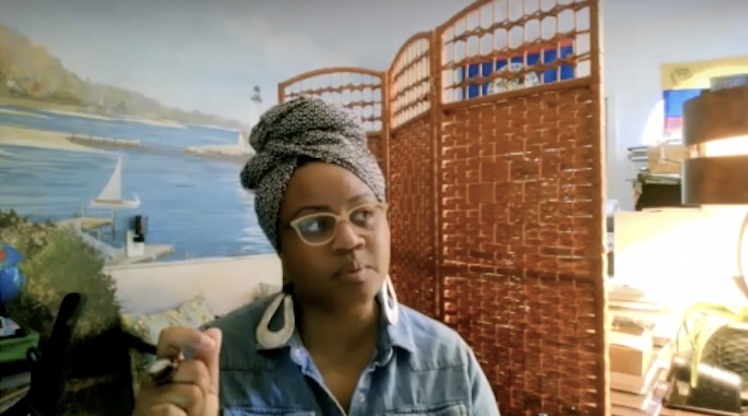Elaine Massacre descendants call for backing up repentance with resources

Clarice Abdul-Bey, the co-convener of the Arkansas Peace and Justice Memorial Movement, speaks during an Elaine Unity Fest panel titled "The Elaine Massacre: The Fight for Restorative Justice." (Screenshot via Descendants of the Elaine Massacre of 1919 on YouTube.)
Last year, Lisa Hicks Gilbert was running a Facebook page and hosting Zoom events for those who, like her, descended from victims of the 1919 Elaine Massacre, when mobs of white people instigated by white planters killed, arrested, and displaced hundreds of Black people in Phillips County, Arkansas, following an organizing attempt by Black sharecroppers. Back then, she was hoping to create a space where descendants of the victims could heal together and take the lead on restorative justice in Elaine, a rural Arkansas Delta town whose population of just over 500 is 71% Black.
Today, Gilbert, the founder of the Descendants of the Elaine Massacre of 1919, is in the midst of moving back home to Elaine, where she'll help run programming at the Lee Street Community Center and work to fulfill the vision that she and other descendants have been talking about for the past year.
Part of that vision is the annual Elaine Unity Fest, which was held for the first time last weekend, on the 102nd anniversary of the massacre. Though this year's festival was virtual, Gilbert and her co-organizers plan to hold it at the old Elaine High School in the future. The high school, which closed along with the rest of Elaine's public schools several years ago, is now owned by the Elaine Alumni Association.
This year's Unity Fest included a town hall, a panel on restorative justice, a writing workshop, and a church service. Its sponsors included the Delta Commons Group, the University of Arkansas for Medical Sciences (UAMS), the Emmett Till National Park Campaign, Holding Spaces, The Magic Soul, and Damaged Heritage. The festival was not without its challenges: Its virtual nature, dictated by the ongoing COVID-19 pandemic, meant that some Elaine residents could not attend due to a lack of adequate internet service.
Many of the issues faced by Elaine and Phillips County are, descendants believe, a direct result of the massacre and its aftermath. Local authorities arrested 122 Black people and spuriously charged them with crimes; 12 were sentenced to death. In her pamphlet "The Arkansas Race Riot," investigative journalist Ida B. Wells-Barnett calculated the money lost by families of the Elaine Twelve because they were unable to harvest their cotton as they sat in the Phillips County jail to be at least $86,050 — over $1.3 million in today's dollars. Wells-Barnett estimated that a full accounting of the cotton profits lost by families of murdered or jailed Black sharecroppers — money that largely went into the pockets of white planters — would add up to $1 million, or almost $16 million today.
In the decade following the massacre, 5,660 Black people moved away from Phillips County — a spike in the out-migration of Black people from that area. All of the Elaine Twelve moved out of state following the mitigation of their sentences; only one, Joseph Knox, would permanently return to Arkansas.
One of the first to leave was Robert Lee Hill, the organizer of the Progressive Farmers and Household Union of America, which was meeting in a church in nearby Hoop Spur the night the massacre began. Fleeing from white posses and potential arrest, Hill went first to Oklahoma and then to Kansas, where he was arrested by local authorities in 1920. The NAACP campaigned against his extradition to Arkansas, and he was eventually freed; he lived the remainder of his life in Topeka. One of Hill's descendants, his great-niece Charlotte "Mama C" Hill O'Neal, who is the co-director of the United African Alliance Community Center in rural Tanzania, recorded a video titled "The Blood That I Carry" reflecting on her great-uncle's legacy and the work for justice and equity she carries on.
"I knew that the blood that I carry, the blood that screams for freedom, the blood that spreads love, the blood that is so similar to what my great-uncle talked about when he formed the Progressive Farmers and Household Union of America … I knew that great-uncle Robert Lee Hill had to have been the one who they always talked about," O'Neal said. "And now I know why the conversations were so whispered."
'We have to have broadband'
During a Friday morning session on restorative justice, panelists lamented the fact that recent apologies and acknowledgments of the massacre from white Arkansans and state officials have not led individuals, philanthropies, or governments to invest more in Elaine.
"I would implore more action, more restoration, more transformation, more being involved in the issue at hand, the issues that devastate our community," said Clarice Abdul-Bey, the co-convener of the Arkansas Peace and Justice Memorial Movement and a descendant of a Black family who lived in the area at the time of the massacre.
"If you have the capital, and you express remorse … and you have connections or resources, repentance is fine," Abdul-Bey continued. "But the restoration of helping thousands of young folks and people being able to look at homework, to be technologically savvy, to be able to go on the internet, to be able to do telemedicine, to be able to do mental health telemedicine, all of these things are very important. I want to connect repentance to resources to change."
High-speed internet could bring all sorts of opportunity to the community, Gilbert believes. With internet, they could put a call center in the old high school that would create jobs. With internet, they could host concerts not just for the community, but to drive tourism and economic development.
"We have to have broadband, and there's money out there for it," Gilbert said. "Here we are again. During that massacre, no one came to help Elaine. No one came to help. And here we are again, they're still not trying to help. Where are our state representatives, our local representatives? Where are you?"
On the Friday call, panelists also pointed to the city's rusting water tower, a photo of which was featured in a recent USA Today investigation into pathogens in water towers. Elaine's water, they said, often comes out of the taps discolored.
"The water situation in Elaine has been an issue for years," Gilbert said during the panel on restorative justice. "That's not just the water that comes into people's homes, but also the pipes, the sewage system. When it rains, if we get a lot of rain, that means they have sewage backups." Gilbert said that Elaine residents have tried to bring water and sewage issues to the attention of the city and the mayor, to no avail; Mayor Michael Craven, who did not attend the Unity Fest, did not respond to an emailed request to be interviewed for this article.
Gilbert has also been in conversation with UAMS about bringing a telemedicine clinic to Elaine, which would be housed in the old high school. Currently, people living in Elaine must travel at least 30 minutes to Marvell or Helena-West Helena for medical care; there is no ambulance in the town. "If you can't get doctors to come out to those rural areas, why not connect them up over interactive video?" said Terri Imus, the director of operations for clinical telemedicine at UAMS, who has been working with Gilbert on envisioning the telemedicine operation.
The barriers right now are broadband and funding. Imus estimates that they need less than $50,000 in startup costs, and internet that allows for video calls and uploads. The equipment to set up a telemedicine clinic is relatively simple — a mobile cart with a camera, lenses, and a stethoscope that would allow doctors to virtually examine patients' heart and lung sounds, as well as lesions and wounds, and medical equipment to be housed in the exam room. Federal grant money and COVID relief aid has dried up for the moment, but Imus says they're still searching for funds.
"We don't care where the money comes from," Imus said. "A Walton or a Rockefeller, someone that's got some money that they need to give away, we'll take it."
Test the waters
Besides working with organizations in and outside of Elaine to bring services and economic revitalization to the town, Gilbert will be working to maintain the park at the Lee Street Community Center and to create youth programming.
"I want to create a leadership program, but I want to start by asking [the youth], 'What do you want to see in your community? What does that look like? What does the leadership program look like?'" she said. She hopes that by being in Elaine and working to bring the community's needs to the forefront, she can encourage others to talk more openly about the massacre and its ongoing effects — conversations that are often still whispered, still controversial — and that the town, Black and white residents alike, can move towards restorative justice, reconciliation and unity.
Her first effort to engage students in these reconciliation efforts was a student essay contest for Phillips County students on the topic of racial reconciliation as exemplified by the late Sheila Walker, a descendant of one of the Elaine Twelve, and J. Chester Johnson, whose grandfather participated in the massacre. She had just one entry, which she says is indicative of the culture of silence and fear that still exists around acknowledging the history and legacy of the massacre in Phillips County — and the current fraught climate around teaching the history of racism.
"With all the talk around critical race theory, teachers are scared to touch on certain subjects. And I mean, this was about reconciliation," she said. "But it was intentional. I had to test the waters. I'm going into it seemingly blind, but I had to test the waters to see what am I faced with."
Tags
Olivia Paschal
Olivia Paschal is the archives editor with Facing South and a Ph.D candidate in history at the University of Virginia. She was a staff reporter with Facing South for two years and spearheaded Poultry and Pandemic, Facing South's year-long investigation into conditions for Southern poultry workers during the COVID-19 pandemic. She also led the Institute's project to digitize the Southern Exposure archive.
